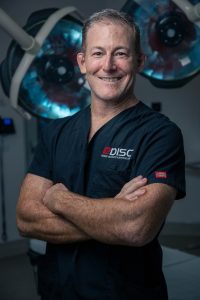
Scoliosis is a condition that causes a sideways spinal curvature. While it commonly appears in young children, it can also begin causing symptoms during adulthood. Scoliosis can be challenging to diagnose, but understanding the signs can help you recognize it faster and seek medical advice concerning treatment.
People with mild cases can typically continue without treatment, but some patients with more acute curvature can benefit from bracing or surgery. Minimally invasive surgical solutions can increase your comfort and mobility if you have scoliosis.
Scoliosis is a spinal abnormality affecting approximately 3% of Americans. It causes the spine to take on a C or S shape, and can affect different areas of the spine. Some people with scoliosis have minimal or mild spinal curvature, while others have significant curvature that requires specialized treatment or surgery.
Most scoliosis cases are idiopathic — in other words, health professionals are unsure what causes it. Despite the unexplained cause, the medical community believes several factors such as hormones, genes and structural cell changes play a role in idiopathic scoliosis development. Spinal injuries, neuromuscular diseases and tumors can cause non-idiopathic scoliosis. Traumatic injuries and tumors can change the spine, and some neuromuscular diseases alter how nerves communicate with muscles, weakening the muscles surrounding the spine.
Congenital scoliosis develops in the womb before birth, and neuromuscular scoliosis occurs due to a muscular or neurological condition such as cerebral palsy, a spinal cord injury or muscular dystrophy.
You should visit a spine specialist if you notice the following scoliosis symptoms.
A spine specialist has the knowledge and experience to test you for scoliosis and make an accurate diagnosis. When you visit a spine specialist, your provider may order an X-ray to get a comprehensive view of your spine and evaluate the size of the curve. Spine specialists also use a scoliometer to measure your spine’s curvature, determine if you require treatment and track curvature progression through further observation.
If a spine specialist diagnoses you with scoliosis, they may recommend one or all the following treatments depending on your spinal curvature, progression and age.
Observation allows spine specialists to track changes in your spine. Periodic checkups can reveal how progressive the scoliosis is and how quickly it alters your spine’s alignment. Providers closely observe scoliosis cases in children because their spines are still growing and developing. However, your provider may also want to examine you as an adult if your condition shows signs of quick progression. A non-progressing case of scoliosis may have minimal impact on your daily life, but a progressive case typically requires intervention to prevent discomfort and further curvature.
Bracing is more common during childhood and adolescence, but you may also benefit from a brace if you develop scoliosis or find your condition worsening during adulthood. Wearing a specialized back brace for a prescribed period during the day or night supports the spine to prevent its curvature from progressing. If a provider recommends this solution, they will tell you how many hours to wear the brace daily.
Spinal injections are a short-term pain management solution. A provider can inject a local anesthetic and steroids into the affected areas of your back, providing pain relief for a few months or weeks.
Some scoliosis cases improve with surgery. While most people don’t need surgery for their scoliosis, you should consider it if you have the following problems:
Your provider may recommend one of the following solutions if you need scoliosis surgery.
Spine specialists offer minimally invasive procedures to increase post-surgery comfort and reduce or prevent scarring. You can expect a faster, easier recovery time following a minimally invasive surgery like an endoscopic procedure.
Recognizing the signs of scoliosis can help you seek treatment when necessary. While scoliosis is often non-problematic and requires no treatment, it can sometimes cause discomfort and significant misalignment. Managing your spine’s curvature and comfort level can increase your mobility and quality of life. Desert Institute for Spine Care offers expert diagnosis, careful observation and cutting-edge scoliosis treatment.
Our spine specialists have the knowledge, training and experience to accurately diagnose your scoliosis and recommend the best treatment options. As leaders in minimally invasive spine care, we determine the least invasive procedure that will bring you the best possible results, helping you enjoy a faster, more comfortable recovery time. Contact DISC to schedule an appointment and learn more about our compassionate care and innovative treatment solutions.